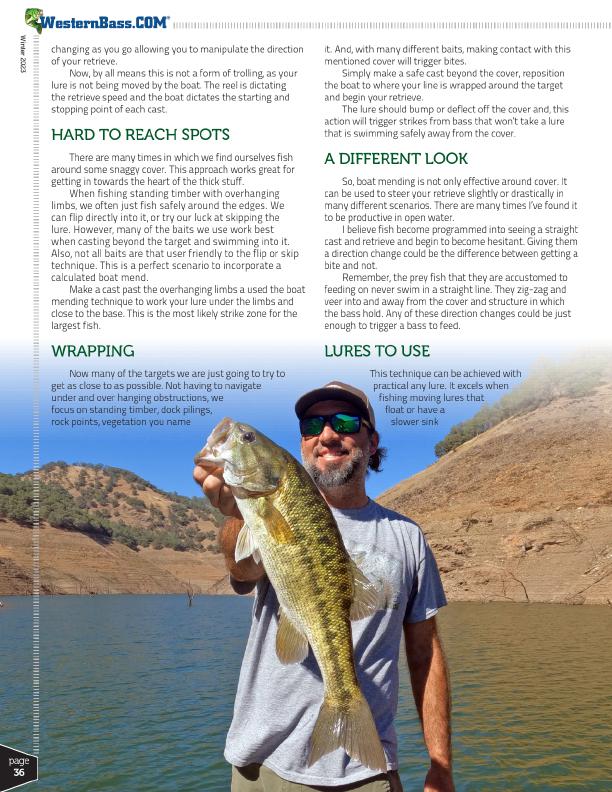
Winter 2023
®
changing as you go allowing you to manipulate the direction of your retrieve.
Now, by all means this is not a form of trolling, as your lure is not being moved by the boat. The reel is dictating the retrieve speed and the boat dictates the starting and stopping point of each cast.
HARD TO REACH SPOTS
There are many times in which we find ourselves fish around some snaggy cover. This approach works great for getting in towards the heart of the thick stuff.
When fishing standing timber with overhanging limbs, we often just fish safely around the edges. We can flip directly into it, or try our luck at skipping the lure. However, many of the baits we use work best when casting beyond the target and swimming into it. Also, not all baits are that user friendly to the flip or skip technique. This is a perfect scenario to incorporate a calculated boat mend.
Make a cast past the overhanging limbs a used the boat mending technique to work your lure under the limbs and close to the base. This is the most likely strike zone for the largest fish.
WRAPPING
Now many of the targets we are just going to try to get as close to as possible. Not having to navigate under and over hanging obstructions, we focus on standing timber, dock pilings, rock points, vegetation you name
it. And, with many different baits, making contact with this mentioned cover will trigger bites.
Simply make a safe cast beyond the cover, reposition the boat to where your line is wrapped around the target and begin your retrieve.
The lure should bump or deflect off the cover and, this action will trigger strikes from bass that won’t take a lure that is swimming safely away from the cover.
A DIFFERENT LOOK
So, boat mending is not only effective around cover. It can be used to steer your retrieve slightly or drastically in many different scenarios. There are many times I’ve found it to be productive in open water.
I believe fish become programmed into seeing a straight cast and retrieve and begin to become hesitant. Giving them a direction change could be the difference between getting a bite and not.
Remember, the prey fish that they are accustomed to feeding on never swim in a straight line. They zig-zag and veer into and away from the cover and structure in which the bass hold. Any of these direction changes could be just enough to trigger a bass to feed.
LURES TO USE
This technique can be achieved with practical any lure. It excels when
fishing moving lures that
float or have a
slower sink
page
36